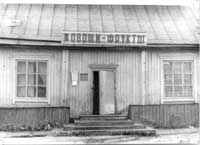EPIGRAPH
THE BEGINNING
THE HISTORY OF BAM
BAMLAG
AFTER THE WAR, BUT BEFORE BAM
THE CITY
THE BIG CITY
THE CELEBRITIES
THE ART AND SOCIAL LIFE
THE FIRST DECADE. 1975-1985.
CHRONOLOGY OF EVENTS.
THE BREAKING POINT
SOUL RELAXATION
CATASTROPHES
WHAT'S LACKING IN THE CITY
WOULD YOU LIKE MORE DETAILS?
TOWNS AND VILLAGES OF THE AREA
EPILOG



Tynda (Biased Notes)
The following essay was not meant to reflect the whole picture,
And the author does not guarantee the unbiased approach.
On the contrary-he guarantees bias, Because he loves his city and he is even proud of its history,
And of the special mentality of its dwellers.
EPIGRAPH
The oracles have fallen over BAM,
Like ravens drop on their pray.
After regaining their sight,
Began to point at blunders of the past
They prophesize about what's already happened.
About what is happening in BAM today.
They write like zealots,
But I believe their efforts are in vain.
Leontiy Makhitarov
"Tynda…Far away in the Russian East a forgotten small city is lost in taiga."
Uh? Everything seems to be correct. Except this fraise brings to my mind a picture of empty dusty streets with chickens running around and grazing cows on the roadside. There is a drunken little man zigzagging along, wearing his "working man" boots. Also, there are some two-story houses in the city center with a five-story apartment building (people proudly refer to it as "the skyscraper") towering over them. The main city street is the only one that's asphalt-paved and some motorcycles zoom by once in a while. And two or three times a week a bus will come from the Region's capital. The paint on the railroad station building has faded. The trains will only stop for a minute and practically nobody comes out of them. An old poster ad invites for a dance session in the local movie house at night, where they haven't shown a movie for a while…
Come on now! Stop this nonsense! Tynda is not like this. Not like this at all.
Tynda. Our city is small, and is getting smaller. The population is catastrophically shrinking from 60 thousand to 40. Yes, it's far in the East. Yes, it's in taiga. But it's not lost. Not lost at all. And it's not forgotten. Periodic bursts of interest towards the BAM region cause heated debates in the State Duma. In the "Public Education" magazine, our Gymnasium #1 (academic High School) was mentioned as "a unique manifestation not analogous in the education." People come here from all over the country for the theater and song festivals. There are two large public libraries; one of them is technology-science oriented. Also, there are now two drama theaters, a soft drink manufacturing-bottling facility, a TV station and a documentary movie studio. The rest I am not going to list right now.
Tynda is a beautiful city in its center with suburbs still in development. The city that should have a population of 100 thousand has less than 50 thousand.
Tynda area is part of the Amur Region, making up its Northwest section. In the west the area borders the Chita Region. In the north and northeast it borders Yakutia (Sakha). In the East it borders Zeya area, in the southeast - Margdagachi area, and in the south - Skovorodino area.
Tynda area is in the 8th time belt (zone), where the difference with
Moscow time is 6 hours. When it's night in Moscow, it's sunrise here.
The area is situated in a moderate geographic belt, in between 53rd and
57th degree latitude. If one were to move our area over to the European
part of Russia, it would turn out that the area's northern point is near
the city of Tver and its southern point is near Tula. Southern part of
Canada in the Western Hemisphere falls on the same latitude as our area
does.
In the north, Tynda border goes along the Stanovoi Mountain Range; in
the south if goes along the foothills of the Urushinsky and Yankan Mountain
Ranges and also along the Urkan River. In the west and east there aren't
any clearly defined geographic borders.
Tynda area covers 83.3 thousand squared kilometers and comprises almost a fifth of the Amur Region. For instance, this area is equal to the area of Austria and is larger than Ireland. The area's length from north to south - 252 km; from west to east (Tynda latitude) - 369 km; and from northwest to southeast - 486 km. The administrative center of the area is Tynda. The city is situated in the eastern section (near the merging point of Getkan River with Tynda River), 500 meter above the sea level.
Tynda is the Northern most and the youngest city of the Amur Region. The city's area is 124 squared kilometers. As of January 1, 2000, the population was 46.3 thousand. Tynda is city of Regional subordination. The city is a major transportation junction in the Northwest of the Amur Region where Taishet-Urgal and Bamovskaya-Berkakit railroad lines cross.
The distance between Tynda and its regional capital Blagoveschensk is
840 km; between Moscow and Tynda - 8 thousand km (by air - 6.5 thousand
km). According to National Census of 1989, the city was a home to more
than 10 nationalities: 74% -- Russian, 12.5% -- Ukrainian, 2.7% -- Byelorussian.
The median population age was 25.9 years old. The city's population density
is 386 people per 1 sq. km.